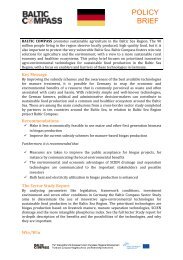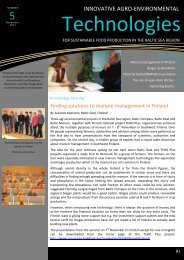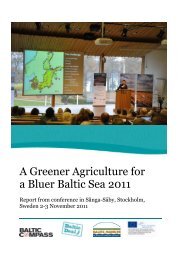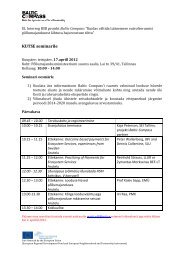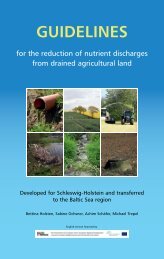Country Report Sweden (DRAFT) - Baltic COMPASS
Country Report Sweden (DRAFT) - Baltic COMPASS
Country Report Sweden (DRAFT) - Baltic COMPASS
You also want an ePaper? Increase the reach of your titles
YUMPU automatically turns print PDFs into web optimized ePapers that Google loves.
27in a different way.In areas outside vulnerable areas, where applicable the following points should be takeninto account when determining storage volume:• Quantity of faeces and urine excreted. Factors such as species on the basis of the typeof production, number of animals, diet and stocking density should be taken into accountwhen calculating the quantity of faeces and urine excreted.• Addition of litter.• Water inflow due to wastewater, washing-up water and cleaning water and in the form ofprecipitation falling on to storage areas or other areas which are drained to storage tanks.• Conversion losses that entail diminishing volumes of fertiliser during the storage period insystems with large amounts of litter.Section 4a. In vulnerable areas, where applicable the following points must be taken intoaccount when determining storage volume:• Quantity of faeces and urine excreted. Factors such as species on the basis of the typeof production, number of animals, diet and stocking density should be taken into accountwhen calculating the quantity of faeces and urine excreted.• Addition of litter.• Water inflow due to wastewater, washing-up water and cleaning water and in the form ofprecipitation falling on to storage areas or other areas which are drained to storage tanks.• Conversion losses that entail diminishing volumes of fertiliser during the storage period insystems with large amounts of litter. (SJVFS 2009:82)Section 4b: In vulnerable zones, records must be kept of how the storage volume inaccordance with Section 4a has been calculated. The records must be kept, and beaccessible, for as long as the calculations continue to apply to the holding. (SJVFS2009:82)Section 5: Section 7 of Ordinance (1998:915) on environmental concerns in agriculturecontains requirements governing the design of storage spaces for livestock manure.(SJVFS 2010:1)Section 5a: Slurry and urine containers must have a stable natural crust or other coveringwhich effectively reduces ammonia losses. If a natural crust or other covering on acontainer is broken or damaged it should be restored as soon as possible. (SJVFS2010:1)If the natural crust on a slurry container is damaged or broken when stirring or spreadingthe manure a stable natural cover should have been restored within 14 days. If thecontainer is completely emptied a somewhat longer time is acceptable if the manure levelin the container is so low that for practical reasons it is not possible, for example, to mix insolid manure or straw. In the event of the container being emptied, the restoration periodshould be counted from when manure starts being put into the container. A stable naturalcrust on a urine container should be restored within 7 days following spreading.If another covering, such as a roof, is damaged it must be repaired within 14 days. If this isnot practically possible an alternative covering should be used in order to minimiseammonia losses during the period needed to repair the damage to the original covering.Section 5b: Urine and slurry containers must be filled with urine and slurry under cover,



